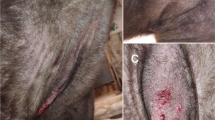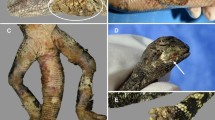Abstract
Demodicosis is most frequently observed in the domestic dog (Canis familiaris), but it has rarely been reported in bats (Chiroptera). The overpopulation of Demodex spp. that causes dermatological changes is generally associated with a compromised immune system. We describe the gross and histological features of generalized demodicosis in an adult female African straw-coloured fruit bat (Eidolon helvum) drawn from a captive research colony. The histology of the lesions revealed comedones and follicular infundubular cysts harbouring numerous Demodex spp. mites, eliciting a minimal inflammatory response in the adjacent dermis. The histological examination of a full set of tissues did not reveal clear evidence of immunosuppression, although a clinical history of recent abortion and possible stressors due to captivity could be considered risk factors for the demodicosis. Attempts to determine the Demodex species using PCR on DNA extracted from the formalin fixed paraffin embedded tissue failed. This is the first clinical and histological description of demodicosis in Eidolon helvum.


Similar content being viewed by others
References
Baker KS, Leggett RM, Bexfield NH, Alston M, Daly G, Todd S, Tachedjian M, Holmes CE, Crameri S, Wang LF, Heeney JL, Suu-Ire R, Kellam P, Cunningham AA, Wood JL, Caccamo M, Murcia PR (2013) Metagenomic study of the viruses of African straw-coloured fruit bats: detection of a chiropteran poxvirus and isolation of a novel adenovirus. Virology 441:95–106
Baker KS, Suu-Ire R, Barr J, Hayman DT, Broder CC, Horton DL, Durrant C, Murcia PR, Cunningham AA, Wood JL (2014) Viral antibody dynamics in a chiropteran host. J Anim Ecol 83:415–428
Childs-Sanford SE, Kollias GV, Abou-Madi N, McDonough PL, Garner MM, Mohammed HO (2009) Yersinia pseudotuberculosis in a closed colony of Egyptian fruit bats (Rousettus aegyptiacus). J Zoo Wildl Med 40:8–14
Dedhia P, Tarale S, Dhongde G, Khadapkar R, Das B (2007) Evaluation of DNA extraction methods and real time PCR optimization on formalin-fixed paraffin-embedded tissues. Asian Pac J Cancer Prev 8:55–59
Desch CE (1989) Two new species of Demodex (Acari: Demodicidae) from the New Zealand short-tailed bat, Mystacina tuberculata Gray, 1843 (Chiroptera: Mystacinidae). N Z J Zool 16:221–229
Fountain KI, Stevens KB, Lloyd DH, Loeffler A (2017) Skin disease in captive bats: results of an online survey of zoos and rehabilitators in Europe, North America and Australasia. Vet Dermatol 28:219–223
Gross TL, Ihrke PJ, Walder EJ, Affolter VK (2005) Pustular and nodular disease with adnexal destruction. In: Gross TL, Ihrke PJ, Walder EJ, Affolter VK (eds) Skin diseases of the dog and cat: clinical and histopathologic diagnosis, 2nd edn. Wiley, New York, pp 420–459
Kitano T, Umetsu K, Tian W, Osawa M (2007) Two universal primer sets for species identification among vertebrates. Int J Legal Med 121:423–427
Lankton JS, Chapman A, Ramsay EC, Kania SA, Newkirk KM (2013) Preputial Demodex species in big brown bats (Eptesicus fuscus) in eastern Tennessee. J Zoo Wildl Med 44:124–129
Mathison BA, Pritt BS (2014) Laboratory identification of arthropod ectoparasites. Clin Microbiol Rev 27:48–67
Mauldin EA, Peters-Kennedy J (2015) Integumentary system. In: Grant Maxie M (ed) Jubb, Kennedy, and Palmer’s pathology of domestic animals, 6th edn. Saunders Ltd, Philadelphia, pp 509–736
Mühldorfer K, Speck S, Kurth A, Lesnik R, Freuling C, Müller T, Kramer-Schadt S, Wibbelt G (2011) Diseases and causes of death in European bats: dynamics in disease susceptibility and infection rates. PLoS ONE 6:e29773
Otto JC, Wilson K (2001) Assessment of the usefulness of ribosomal 18S and mitochondrial COI sequences in Prostigmata phylogeny. In: Acarology: Proceedings of the 10th International Congress—CSIRO Publishing, pp 100–109
Rait VK, Zhang Q, Fabris D, Mason JT, O’Leary TJ (2006) Conversions of formaldehyde-modified 2′-deoxyadenosine 5′-monophosphate in conditions modeling formalin-fixed tissue dehydration. J Histochem Cytochem 54:301–310
Sastre N, Francino O, Curti JN, Armenta TC, Fraser DL, Kelly RM, Hunt E, Silbermayr K, Zewe C, Sánchez A, Ferrer L (2016) Detection, prevalence and phylogenetic relationships of Demodex spp and further skin prostigmata mites (Acari, Arachnida) in wild and domestic mammals. PLoS ONE 1:e0165765
Vargas M, Bassols IB, Desch CE, Quintero MT, Polaco OJ (1995) Description of two new species of the genus Demodex Owens, 1843 (Acari: Demodecidae) associated with mexican bats. Intern J Acarol 21:75–82
Zewe CM, Altet L, Lam ATH, Ferrer L (2017) Afoxolaner and fluralaner treatment do not impact on cutaneous Demodex populations of healthy dogs. Vet Dermatol 28:468
Zhao YE, Wu LP (2012) Phylogenetic relationships in Demodex mites (Acari: Demodicidae) based on mitochondrial 16S rDNA partial sequences. Parasitol Res 111:1113–1121
Zhao Y, Ma J, Hu L, Wu L, De Rojas M (2013) Discrimination between Demodex folliculorum (Acari: Demodicidae) isolates from China and Spain based on mitochondrial cox1 sequences. J Zhejiang Univ Sci B 14:829–836
Acknowledgements
The authors thank Richard Irvine for his constructive review of the manuscript.
Funding
This work was part-funded by a Wellcome Trust Research Training Fellowship (KSB) and KSB is supported by a Wellcome Trust Clinical Career Development Fellowship (106690/Z/14/Z).
Author information
Authors and Affiliations
Corresponding author
Ethics declarations
Conflict of interest
The authors declared no potential conflicts of interest with respect to the research, authorship and/or publication of this article.
Additional information
Publisher's Note
Springer Nature remains neutral with regard to jurisdictional claims in published maps and institutional affiliations.
Rights and permissions
About this article
Cite this article
Bianco, C., Baker, K.S., Pazzini, L. et al. Demodicosis in a captive African straw-coloured fruit bat (Eidolon helvum). Exp Appl Acarol 78, 547–554 (2019). https://doi.org/10.1007/s10493-019-00399-9
Received:
Accepted:
Published:
Issue Date:
DOI: https://doi.org/10.1007/s10493-019-00399-9




